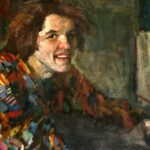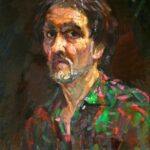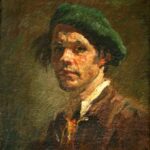
Kmieliauskas Antanas
Professor of the Vilnius Academy of Arts, laureate of the Lithuanian National Prize, one of the most versatile contemporary Lithuanian artists, working in the fields of sculpture, graphics, easel painting and fresco. Much of his work, especially religious art, has been undeservedly ignored for a long time. The work of a distinctive artist, based on both the fundamental traditions of classical and modernist European art, is a significant part of our art and Lithuanian culture in general.
A. Kmieliauskas was born on March 8, 1932 in Olendernė, Alytus County, near the town of Butrimoniai.
From 1939 to 1947, he studied at Butrimoniai Primary School and Jiezna Gymnasium,
From 1947 to 1949, he continued his studies at Butrimoniai Progymnasium.
In 1949, he went to study at Kaunas Secondary Art School (later named J. Naujalis Secondary Art School, now – Art Gymnasium). As soon as he arrived in Kaunas to take the entrance exams, he visited the M. K. Čiurlionis Art Museum. Čiurlionis made an extraordinary impression on him, and the Soviet art exhibition held nearby disappointed him with its uninteresting works, so he began to consider whether he still wanted to be an artist. He graduated from Kaunas Secondary Art School with a gold medal in 1951, and in the same year he entered the State Art Institute, majoring in painting.
1951-1957 – studies at the Art Institute. The ambiguous political situation of that time, when the reality of life was frightening, and the government portrayed life as good and joyful, was also felt in his work. It was understood that if you do something that is important but officially unacceptable, you will incur trouble, and if you do what is required, although foreign to you, you are calm about the future. The artist experienced this himself when he was forbidden to paint the thematic composition of “Artojus” for his diploma work (his reluctance to join the collective farms was seen). Then A. Kmieliauskas chose portraits.
In 1957, he was accepted into the Artists’ Union as a candidate for membership.
In 1960, he was expelled from there for creating the sculpture “St. Christopher”, which was commissioned by Monsignor Česlovas Krivaitis and which was erected near the Vilnius St. Nicholas Church. In the 1960s, when financial difficulties struck, A. Kmieliauskas created tombstone sculptures according to individual orders.
From 1962 to 1979, he taught drawing and sculpture at the Vilnius Children’s Academy of Art.
In 1966, A. Kmieliauskas’ exlibris was exhibited for the first time at the bookplate exhibition held in Czechoslovakia. Later, the artist also sent his bookplates to exhibitions in various countries.
In 1975, he joined the graphics section of the Artists’ Union, later – the monumental art section. This was influenced by the gold medal awarded in 1974 in Italy for bookplates, which was not awarded to the artist due to the fault of the Soviet authorities.
In 1977, he began teaching at the Institute of Art, first plastic anatomy, then drawing.
In 1994, A. Kmieliauskas was awarded the title of professor.





